
Hawarden is a village and community in Flintshire, Wales. It is part of the Deeside conurbation on the Wales-England border and is home to Hawarden Castle. In the 2011 census the ward of the same name had a population of 1,887, whereas the community of the same name, which also includes Ewloe Mancot and Aston had a population of 13,920. The scenic wooded Hawarden Park abuts the clustered settlement in the south. Hawarden Bridge consists of distribution and industrial business premises beyond Shotton/Queensferry and the Dee. The west of the main street is called The Highway, its start marked by the crossroads with a fountain in the middle, near which are public houses, some with restaurants.

David Davies was a Welsh industrialist and Liberal politician who sat in the House of Commons between 1874 and 1886. Davies was often known as David Davies Llandinam. He is best remembered today for founding Barry Docks.
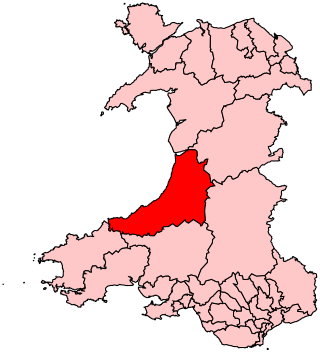
Ceredigion was a parliamentary constituency represented in the House of Commons of the UK Parliament. Created in 1536, the franchise expanded in the late 19th century and on the enfranchisement of women. Its boundaries remained virtually unchanged until 1983. From 1536 until 1885 the area had two seats : a county constituency (Cardiganshire) comprising the rural areas, the other the borough constituency known as the Cardigan District of Boroughs comprising a few separate towns; in 1885 the latter was abolished, its towns and electors incorporated into the former, reduced to one MP. The towns which comprised the Boroughs varied slightly over this long period, but primarily consisted of Cardigan, Aberystwyth, Lampeter and Adpar, the latter now a suburb of Newcastle Emlyn across the Teifi, in Carmarthenshire.

Hawarden Bridge is a railway bridge over the River Dee, near Shotton, Flintshire, Wales. It was built by the Manchester, Sheffield and Lincolnshire Railway, as part of the Chester & Connah's Quay Railway. It opened on 3 August 1889.
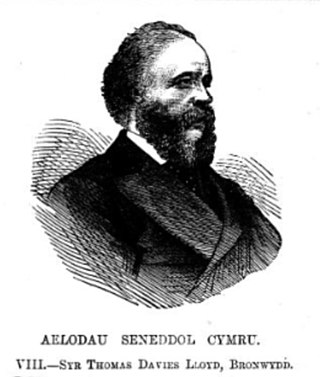
Sir Thomas Davies Lloyd, 1st Baronet was a British Liberal Member of Parliament, for Cardiganshire (Ceredigion) 1865–1868 and Cardigan Boroughs 1868–1874. Although he coveted a peerage and spent a fortune in pursuit of that aim, he had to be content with a baronetcy.
The Cardigan District of Boroughs was a parliamentary constituency in Wales which returned one Member of Parliament (MP) to the House of Commons of the Parliament of the United Kingdom and its predecessors, from 1542 until it was abolished for the 1885 general election. The borough constituency comprised the four towns of Cardigan, Aberystwyth, Lampeter and Adpar - geographically separated from each other but all within the county of Cardiganshire.

Ynysymaengwyn was a gentry house in the parish of Tywyn, Gwynedd, situated near the left bank of the River Dysynni. The name means 'the white stone island'.
The office of High Sheriff of Cardiganshire was established in 1541, since when a high sheriff was appointed annually until 1974 when the office was transformed into that of High Sheriff of Dyfed as part of the creation of Dyfed from the amalgamation of Cardiganshire, Carmarthenshire and Pembrokeshire. Between the Edwardian Conquest of Wales in 1282 and the establishment of the High Sheriff of Cardiganshire, the sheriff's duties were mainly the responsibility of the coroner and the Custos Rotulorum of Cardiganshire. The office of High Sheriff remained first in precedence in the county until the reign of Edward VII when an Order in Council in 1908 gave the Lord Lieutenant of Cardiganshire the prime office under the Crown as the sovereign's personal representative.
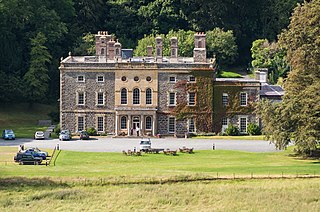
Nanteos is an 18th-century former country house in Llanbadarn-y-Creuddyn, near Aberystwyth, Ceredigion, Wales. A Grade I listed building, it is now a country house hotel. The gardens and parkland surrounding the mansion are listed on the Cadw/ICOMOS Register of Parks and Gardens of Special Historic Interest in Wales.
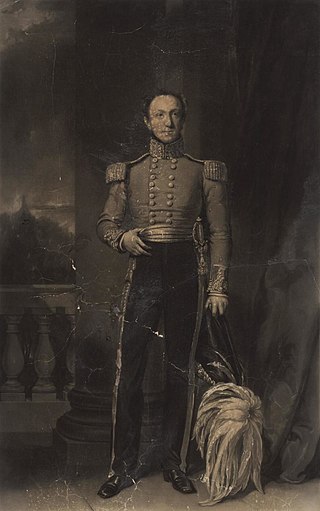
William Edward Powell was a Welsh Lord Lieutenant and Conservative Party politician who served as the Member of Parliament (MP) for Cardiganshire from 1816 until shortly before his death in 1854.

Trawsgoed is a community and an estate in Ceredigion, Wales. The estate is 8 miles (13 km) southeast of Aberystwyth, and has been in the possession of the Vaughan family since 1200. The Vaughans are descended from Collwyn ap Tangno, founder of the fifth noble tribe of North Wales, Lord of Eifionydd, Ardudwy, and part of Llŷn, who had his residence on the site of Harlech Castle.
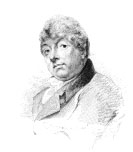
Thomas Johnes FRS was a Member of Parliament, landscape architect, farmer, printer, writer and social benefactor. He is best known for his development of the Hafod Estate in Wales.
Sir Richard Pryse was a Welsh politician who sat in the House of Commons from 1584.
Rowland Pugh was a Welsh politician who sat in the House of Commons from 1624 to 1625.
John Lloyd Davies was a Welsh lawyer and politician, originally from the Aberystwyth area, who represented Cardigan boroughs in Parliament between 1855 and 1857.
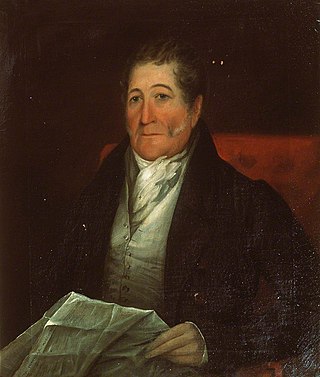
Pryse Loveden Pryse of Gogerddan, Cardiganshire and Buscot Park, Berkshire was a British Lord Lieutenant and Member of Parliament for Cardigan Boroughs from 1818 until his death in 1849.
Thomas Edward Lloyd was a British Conservative Party politician. He was Conservative MP for Cardiganshire from 1874 to 1880.

Evan Matthew Richards was a Welsh Liberal politician who represented Cardiganshire in the British House of Commons from 1868 until his defeat at the general election of 1874.

Colonel Edward Lewis Pryse was a British Liberal politician.

The 2022 United Kingdom heatwaves were part of several heatwaves across Europe and North Africa. The United Kingdom experienced three heatwaves; the first was for three days in June, the second for three days in July, and the third for six days in August. These were periods of unusually hot weather caused by rising high pressure up from the European continent. There were also more grass fires and wildfires than average, and in August a drought was declared in many regions.















